Filter interviews by
Ramacivil India Construction Safety Manager Interview Questions and Answers
Ramacivil India Construction Safety Manager Interview Experiences
1 interview found
(2 Questions)
- Q1. Your Profile no comments
- Q2. Safety field , how to be improved hse culture
- Ans.
Improving HSE culture in the safety field requires strong leadership, effective communication, continuous training, and employee engagement.
Promote leadership commitment to safety by setting clear expectations and leading by example
Enhance communication channels to ensure all employees are informed about safety protocols and procedures
Provide regular training sessions on safety practices and procedures to keep employee...
Interview Preparation Tips
Top trending discussions






Interview questions from similar companies

I applied via Walk-in and was interviewed before Jul 2020. There were 4 interview rounds.
Interview Questionnaire
1 Question
- Q1. Education and previous work details
Interview Preparation Tips

Assistant Manager Interview Questions & Answers
S P Singla Constructionsposted on 10 Oct 2024
(1 Question)
- Q1. Accounts related

Assistant Manager Interview Questions & Answers
Ramky Infrastructureposted on 10 Nov 2021
Interview Questionnaire
4 Questions
- Q1. What will you do when material is not received in time at site ?
- Ans.
I will assess the situation and take necessary actions to minimize the impact on the project timeline.
Check with the supplier for the reason of delay and expected delivery date
Evaluate the impact on the project timeline and inform the project team
Explore alternative options such as sourcing from a different supplier or adjusting the project schedule
Communicate the revised plan to all stakeholders and ensure timely deli...
- Q2. How do you manage the team ?
- Ans. Should maintain proper communication between team members. Good planning assists allocation of work responsibilities to team members, also it avoids irrational approach and duplication of works. As a best team player can complete the project within a specified time and budget.
- Q3. How do you calculate the cement and sand for 1 sqm cm 1:4?
- Ans.
To calculate cement and sand for 1 sqm cm 1:4, use the formula: (1/5.5) * 1 = 0.18 cubic meters of cement and (4/5.5) * 1 = 0.73 cubic meters of sand.
The ratio of cement to sand is 1:4
Calculate the total volume of the mixture, which is 1 sqm cm
Divide the total volume by the sum of the ratio (1+4=5)
Multiply the quotient by the individual ratio to get the volume of cement and sand
Convert the volume to weight using the de
- Q4. What is price escalation?
- Ans.
Price escalation refers to the increase in the price of goods or services over time.
It is a common phenomenon in the market due to inflation, changes in demand and supply, and other economic factors.
Price escalation can also occur due to changes in the cost of production, such as raw material costs, labor costs, and transportation costs.
For example, the price of gasoline may escalate due to an increase in the cost of c...
Interview Preparation Tips

Assistant Manager Interview Questions & Answers
Ramky Infrastructureposted on 13 Aug 2022
I applied via Approached by Company and was interviewed in Jul 2022. There was 1 interview round.
(2 Questions)
- Q1. What is my strength?
- Ans.
My strength is my ability to lead and motivate a team towards achieving goals.
Effective communication skills
Strong decision-making abilities
Ability to delegate tasks efficiently
Positive attitude towards challenges
Experience in managing teams
Motivational skills
Goal-oriented mindset
- Q2. What is my weakness?
Interview Preparation Tips
- Technicals

Assistant Manager Interview Questions & Answers
Ramky Infrastructureposted on 29 Dec 2023
I applied via Walk-in and was interviewed before Dec 2022. There were 2 interview rounds.

(1 Question)
- Q1. Nothing just basic information and then they are conducting technical round based on your profile or department
Interview Preparation Tips

Assistant Manager Interview Questions & Answers
Ramky Infrastructureposted on 22 Oct 2024
I applied via Referral and was interviewed before Oct 2023. There was 1 interview round.
(2 Questions)
- Q1. Rate analysis for building Items
- Ans.
Rate analysis for building items involves calculating the cost of materials, labor, and overhead for each item in a construction project.
Rate analysis helps in determining the cost of each building item based on material and labor costs.
It involves breaking down the total cost into components like material cost, labor cost, and overhead expenses.
Rate analysis helps in estimating the total project cost accurately.
For ex...
- Q2. Material Rates of building materials
- Ans.
Material rates of building materials vary based on factors like location, quality, and demand.
Material rates can vary based on the location of the construction site.
The quality of the building materials can also impact the rates.
Demand for certain materials can cause fluctuations in prices.
For example, the rate of cement in urban areas may be higher compared to rural areas.
Higher quality bricks may cost more than lower...

Assistant Manager Interview Questions & Answers
Ramky Infrastructureposted on 21 Feb 2022
(2 Questions)
- Q1. What is your experience
- Ans.
I have 5 years of experience in management roles, including 2 years as an Assistant Manager.
5 years of management experience
2 years as an Assistant Manager
Successfully led a team of 10 employees
Implemented new strategies to improve productivity and efficiency
Trained and mentored new employees
- Q2. What is the thickness of subgrade
- Ans.
The thickness of subgrade varies depending on the type of construction and soil conditions.
The thickness of subgrade is determined based on the load-bearing capacity required for the structure.
It is typically measured in inches or centimeters.
For example, in road construction, the subgrade thickness can range from 6 to 12 inches.
In building construction, it may vary from a few inches to several feet depending on the bu
Interview Preparation Tips

I applied via Company Website and was interviewed before Apr 2020. There were 3 interview rounds.
Interview Questionnaire
12 Questions
- Q1. 1. Make a layout of combined cycle power plant with different structures and components.
- Ans.
Layout of combined cycle power plant with different structures and components.
Combined cycle power plant consists of gas turbine, heat recovery steam generator, and steam turbine.
Gas turbine generates electricity by burning natural gas or oil.
Heat recovery steam generator recovers waste heat from gas turbine exhaust and generates steam.
Steam turbine generates additional electricity using the steam produced by heat reco...
- Q2. 2 How you design machine foundation for Gas turbine. which are the different types of machine foundations.
- Ans.
Designing machine foundation for gas turbine involves several factors and types of foundations.
Factors to consider include soil type, turbine size and weight, seismic activity, and environmental conditions.
Types of foundations include block, pile, and raft foundations.
Block foundations are suitable for smaller turbines on stable soil.
Pile foundations are used for larger turbines or unstable soil.
Raft foundations are us...
- Q3. 3. How you do ductile detailing for beam , column and foundation . which are the IS code you use for ductile detailing.
- Ans.
Ductile detailing for beam, column, and foundation involves following IS codes and ensuring proper reinforcement placement.
For beams, IS 13920 is followed and reinforcement is placed at the bottom of the beam.
For columns, IS 13920 and IS 456 are followed and reinforcement is placed in a spiral pattern.
For foundations, IS 13920 and IS 2911 are followed and reinforcement is placed in a specific pattern based on the type ...
- Q4. 4.what are the different type of pile foundation and how you design them .
- Ans.
Pile foundations are used to transfer loads from structures to soil. Different types include driven piles, bored piles, and screw piles.
Driven piles are installed by hammering or vibrating them into the ground.
Bored piles are created by drilling a hole and then filling it with concrete and steel reinforcement.
Screw piles are twisted into the ground using a hydraulic motor.
Design considerations include soil type, load c...
- Q5. 5. How you design shear wall and how you detail it .
- Ans.
Shear walls are designed to resist lateral forces. Detailing includes reinforcement placement and anchorage.
Design shear walls based on the building code requirements and structural analysis.
Select appropriate materials and thickness for the shear wall.
Detail the reinforcement placement and anchorage to ensure proper load transfer.
Provide adequate boundary elements and openings for ducts and pipes.
Consider seismic and ...
- Q6. 6. which are the different software you are using for structural analysis.
- Ans.
I have experience with various software for structural analysis.
STAAD.Pro
SAP2000
ETABS
ANSYS
AutoCAD Structural Detailing
- Q7. 7. How you model raft foundation or shear wall in finet element method.
- Ans.
To model raft foundation or shear wall in finite element method, one needs to follow certain steps.
First, create a 3D model of the foundation or wall using a CAD software.
Next, import the model into a finite element analysis software.
Define the material properties and boundary conditions.
Mesh the model to create finite elements.
Solve the model to obtain the stresses and displacements.
Finally, analyze the results and ma...
- Q8. 8. How you design water retaining structures. which is the IS code you use for water retaining structures. and what is the crack width for water retaining structures.
- Ans.
Water retaining structures are designed as per IS code and crack width is limited to ensure safety.
Design of water retaining structures involves determining the loads, selecting materials, and ensuring stability.
IS 3370 is the code used for design of water retaining structures in India.
The crack width for water retaining structures is limited to 0.2 mm to ensure safety and prevent leakage.
Various types of water retaini...
- Q9. 9. Have you worked with international codes like American and British codes .
- Ans.
Yes, I have worked with both American and British codes.
I have experience working with the International Building Code (IBC) which is based on American codes.
I have also worked with British Standards (BS) such as BS 5950 for structural steel design.
I am familiar with the differences between the two codes and can adapt accordingly.
- Q10. 10. What are the different load combination for RCC and Steal structures .
- Ans.
Different load combinations for RCC and Steel structures.
Load combinations for RCC structures include dead load, live load, wind load, earthquake load, and temperature load.
Load combinations for Steel structures include dead load, live load, wind load, earthquake load, temperature load, and snow load.
Load combinations are determined based on the design codes and standards applicable to the project.
The load combinations...
- Q11. 11. Do you have exposure of site inspection and can you make progress and quality report .
- Ans.
Yes, I have extensive experience in site inspections and creating progress and quality reports.
I have conducted site inspections for various projects in my previous roles.
I am proficient in creating detailed progress and quality reports based on my observations during site inspections.
I have also implemented corrective actions based on the findings of my inspections to ensure project success.
For example, in my previous...
- Q12. 12. Draw a bending moment and shear fonce diagram for portal frame with lateral force and UDL .
- Ans.
To draw a bending moment and shear force diagram for a portal frame with lateral force and UDL.
Calculate the reactions at the supports
Determine the shear force and bending moment at each section
Plot the shear force and bending moment diagrams
Identify the maximum shear force and bending moment
Consider the sign conventions for shear force and bending moment
Use appropriate software or tools for accurate results
Interview Preparation Tips
Skills evaluated in this interview

Interview Questionnaire
1 Question
- Q1. How will you implement ISO systems, and how will you educate site engineers about quality improvements ..
- Ans.
I will implement ISO systems by conducting a gap analysis, creating a plan, and providing training to site engineers.
Conduct a gap analysis to identify areas of improvement
Create a plan to implement ISO systems
Provide training to site engineers on ISO standards and quality improvements
Establish a system for monitoring and measuring quality performance
Encourage continuous improvement through regular audits and reviews
Ramacivil India Construction Interview FAQs
Tell us how to improve this page.
Ramacivil India Construction Interviews By Designations
- Ramacivil India Construction Lab Technician Interview Questions
- Ramacivil India Construction AGM - Projects Interview Questions
- Ramacivil India Construction Assistant Manager Interview Questions
- Ramacivil India Construction Site Engineer Interview Questions
- Ramacivil India Construction Safety Manager Interview Questions
Interview Questions for Popular Designations
- Safety Engineer Interview Questions
- Senior Safety Officer Interview Questions
- Senior Safety Engineer Interview Questions
- Safety Officer Interview Questions
- Fire & Safety Officer Interview Questions
- Safety Supervisor Interview Questions
- Fire & Safety Supervisor Interview Questions
- Senior Safety Supervisor Interview Questions
- Show more
Ramacivil India Construction Safety Manager Interview Process
based on 1 interview
Interview experience
Interview Questions from Similar Companies
|
Civil Engineer
15
salaries
| ₹2.2 L/yr - ₹5.8 L/yr |
|
Civil Site Engineer
15
salaries
| ₹2.5 L/yr - ₹5.2 L/yr |
|
Billing Engineer
12
salaries
| ₹3.6 L/yr - ₹9.2 L/yr |
|
Accountant
10
salaries
| ₹2.7 L/yr - ₹3 L/yr |
|
Civil Foreman
9
salaries
| ₹3.2 L/yr - ₹4.5 L/yr |

Sterling & Wilson

Nasser S. Al Hajri Corporation

Navayuga Engineering Company

Ramky Infrastructure
- Home >
- Interviews >
- Ramacivil India Construction Interview Questions >
- Ramacivil India Construction Safety Manager Interview Questions









